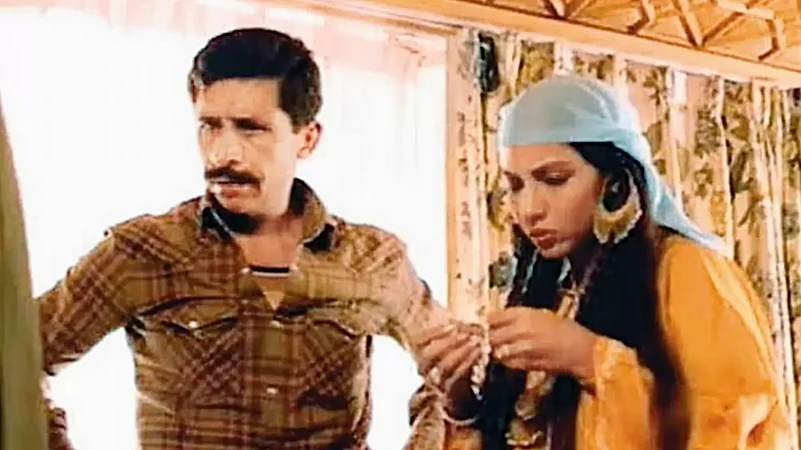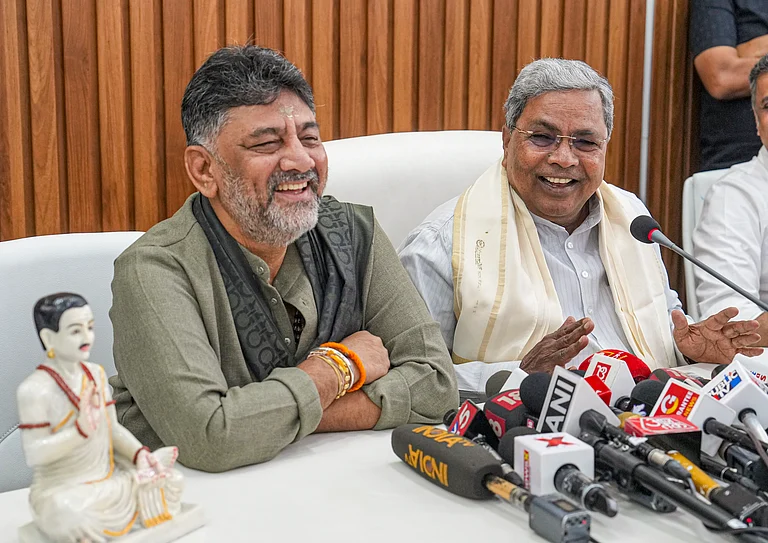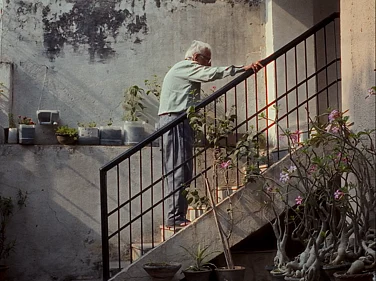An extra is “an additional worker specifically hired to act in a group scene in a motion picture, television or a stage production.” Synonyms used for extras include: ‘junior artists’, ‘atmosphere’, ‘background actors/talent/performers/artists/cast members,’ or simply ‘background.’
India’s first CinemaScope film, Guru Dutt’s Kaagaz Ke Phool (1959) foreground the extra narratively and representationally. The film renders the descent of Suresh Sinha (Guru Dutt) from an idolised filmmaker to a extra within the Ajanta Pictures production house. Twenty-five minutes into the narrative, the audience is introduced to Sinha as a dynamic filmmaker, arriving at a sound studio. This crucial sequence foregrounds two scenes that explicitly address the extra in their absence and presence, respectively.
First, we witness Guptaji, a production manager, hollering at an underling on set, “Musa, have you brought an extra or a roadside beggar? If Mr. Sinha gets angry with me, you’re through.” The yelling is interrupted by Sinha’s arrival on the sets. Guptaji greets the director with a confident “Good morning boss” while Musa mumbles, “Salaam Sahib,” and the chief lighting technician articulates a more equal “Hi boss.” Through the greetings offered to Sinha, a whole hierarchy within film production labour is mapped in which the extra, ultimately, remains invisible and ignored.
In the following scene, a mid-long shot introduces us to Musa shouting at a woman, situated on the left corner of the screen—the margins of the frame. The unnamed woman’s back faces the audience as she nurses an infant, with a young child on her right. The woman is imperceptible, the composition deliberately reducing her to the periphery. Musa aggressively inquires, “Hey, all extras are on the sets. Why are you stuck here?” The woman quickly gets up, passes the infant to her older child, and says, “I will go right away Masterji,” and makes to leave. Musa impedes rather belligerently, “Why didn’t you go to the sets earlier?” The emaciated woman explains that since the baby was wailing with hunger, she decided to feed it. Musa retorts, “If you are so preoccupied with your baby, why have you come to work (as an extra)?” Sinha overhears and intervenes with kindness, directing the woman not to hurry and to report on the sets after putting the infant to sleep. Here, the extra is visible, albeit indiscernibly, till a humane attitude acknowledges her presence and labour.

The narrative purpose is two-fold. First, to establish the central protagonist as a discerning and empathetic filmmaker who has not sacrificed his humanity at the altar of an exploitative film industry. Second, to foreground the plight of the extra, essential to the film’s narrative arc as Sinha’s ascendant trajectory gradually descends to the role of an extra, by the end of the film. Sinha, as an aging and impoverished extra, is treated with much disdain, and dies alone in the director’s chair on the sound stage, bringing the story to full circle. Guru Dutt’s last film accredited to him as director, is widely regarded as an autobiographical contemplation of his deepening disillusionment with the Bombay film industry, post-Independence.
If the sentimental irony of Guru Dutt’s late 1950s cinema, a decade after the euphoria of Indian independence is fuelled by crumbling postcolonial realities, twenty-five years later, in Vidhu Vinod Chopra’s Khamosh, the cinematic vision has darkened considerably. The narrative revolves around the shoot of a fictional film ‘Aakhri Khoon’, a production of Dayal Films International, being filmed in Pahalgam. Soni (Soni Razdan) performs a ‘bit role’ as Zubeida, with aspirations of becoming a leading lady in Dayal’s next production, ‘Shakuntala’. The screenplay requires Zubeida to commit suicide by hanging, eventually tweaked to stage a murder. Leela Bahl (Sushma Seth), who has “been an extra all her life,” as characterised by the film’s screenwriter, also aspires for her daughter Meenu (Noni Ganguly) a high schooler, to be cast as a heroine in the film.
In the seventeenth minute of Khamosh, Zubeida (played by Soni) is murdered and through her life and death, we witness the gendered exploitation of the below-the-line cast. We experience Zubeida’s initial distress, in hanging by a noose from a tree to stage a suicide, as the shoot lingers on its twenty second take. We see a spectrum of predatory men—the lead actor, the cameraperson, the producer, and the producer’s younger brother—flock around Zubeida bearing uninvited romantic or sexual overtures. The narrative also illuminates Meenu’s exploitation through the shooting of a rape scene in twelve takes, in which the actor Dilavar (Avtar Gill) is encouraged to tear Meenu’s clothes and molest her to amplify the salaciousness and saleability of the rape sequence.

Chopra restrains from showing the sordidity by panning on the reaction shots of the crew involved in the shoot—from the director to the cameraperson, the camera assistant to the producer, to the screenplay writer, to the sound recordist, and to the production assistants—all male crew members. The film evokes the sleazy torment of the young below-the-line female cast through sound. It is the female lead Shabana (Shabana Azmi) who defiantly calls for a cut, ending the audience’s aural misery. Khamosh deconstructs the production culture of the 1980s, where mainstream films staged elaborate rape sequences via the gendered exploitation of below-the-line cast in these settings.
Farah Khan’s Om Shanti Om (2007) has been analysed varyingly as a parody, pastiche, and a reflexive postmodern historical tribute to Bombay cinema’s mainstream production cultures. A compelling aspect of the film that has received scant attention is how Khan brings an insider’s knowledge to map the networks of nameless and faceless labour that fuel the Bombay film industry. Khan adroitly exploits both the content and form of Bombay melodrama to mount a reincarnation narrative. In 1977, the protagonist Om Prakash Makhija (Shah Rukh Khan), is a junior artist born to parents who were both junior artists themselves. Om, labouring as an extra, is smitten by the star Shantipriya (Deepika Padukone), is killed while trying to rescue her from a fire on a film set. In a post-interval twist, Om is reborn as superstar Om Kapoor, son of reigning star Rajesh Kapoor (Javed Sheikh). Om Kapoor/OK is established as a spoilt brat, who casually arrives on sets four hours late, doesn’t believe in retakes, and mistreats the crew and his staff. The characterisation of the star has been set up to not only lack ethics, and empathy, but also talent. At an award ceremony, we witness a montage of OK’s nominations, predictable roles clearly pitched to lack any defining acting abilities. In other nomination montages too, the movie economy appears to be sustained by predictability, marketing, and production house franchises. OK’s moment of reckoning arrives when while making a speech after accepting a major film award, he begins to mouth the fantasy speech of the junior artist Om Prakash. In the award’s after-party, OK questions his father about his possibility of acquiring fame, stardom, and awards, had he not been Rajesh Kapoor’s son. The star’s moral redemption comes from reconnecting with his past life and humble origins as a struggling junior artist.
The first half of Om Shanti Om mounts multiple spaces that map the culture of hierarchy in film production: swanky private makeup tents for the stars but collective ones sporting the sign ‘junior artist’, state-of-the-art editing rooms, projection rooms, and sound studios but unkempt rooms for housing costumes and properties. It is within these massive premises that Om and his best friend Pappu (Shreyas Talpade) perform a range of bit roles as dacoits and dancers. That the director used the figure of the junior artist to carry the plot forward is a much-needed acknowledgment of the history of extras in Bombay cinema. In an acerbic critique of Bollywood stardom as class-based ancestry and dynastic, Khan makes it explicit that Om—the junior artist—cannot actualise his aspirational stardom, except through death and reincarnation as Om— the star kid.
All through the film, Khan rigorously reaffirms her narrative and moral affinity with those whose labour goes unacknowledged in the annals of the Bombay film industry. Khan is the daughter of Kamran Khan, a stunman-turned-filmmaker who died a penniless film producer, and Menaka Irani, whose sisters Honey Irani and Daisy Irani, were prominent child actors. She began working in Bollywood as a choreographer. Thus, she brings to the film an insider’s knowledge and cultural memory attained through a ringside view, from the lower rungs of the industry’s hierarchized ladder. In this unique point-of-view lies the strongest accomplishment of Om Shanti Om.
The Bombay film narratives analysed here attempt to foreground the identity of the extra and below-the-line cast, rarely visible in the star-studded firmament of Bombay cinema’s universe. In the invisible world of film production practices, the materiality of this performative labour, almost always lies on the margins, elbowed out by the hyper-visibility of stardom. The spotlighting of this significant cultural work, and its workers, puts a face to the faceless and gives a name to the nameless to hopefully serve as an inspiration for more nuanced film and media narratives around cinematic labour.
(This appeared in the print edition as "Spotlighting Extras")
Priyadarshini Shanker the writer is assistant professor of film studies, University of North Carolina at Wilmington























